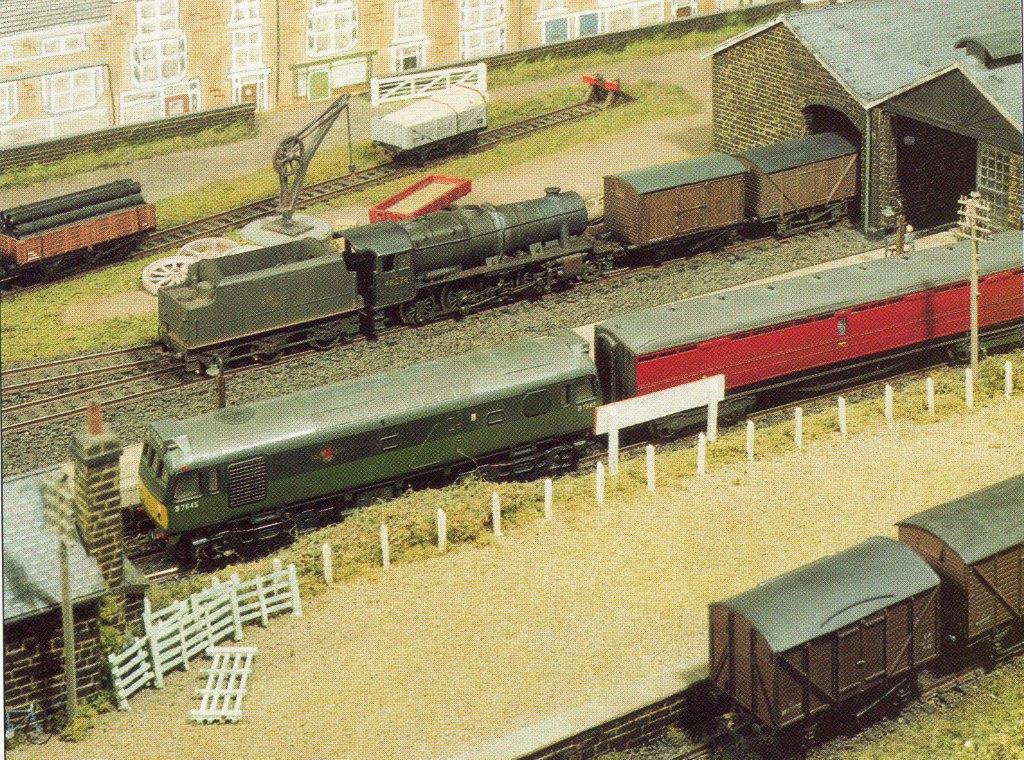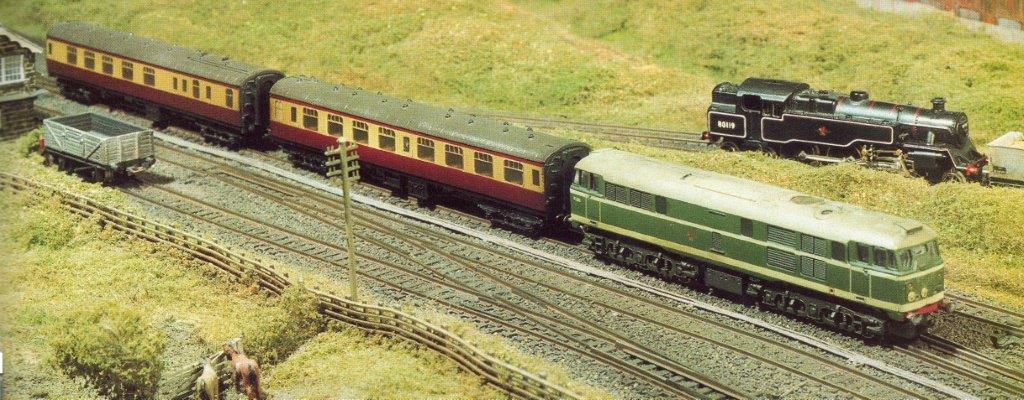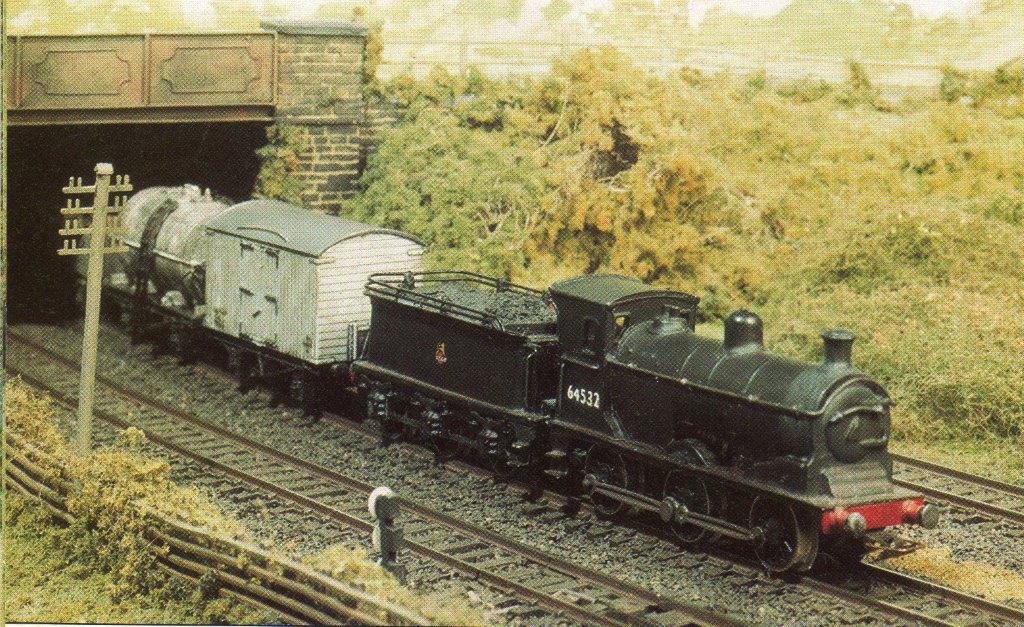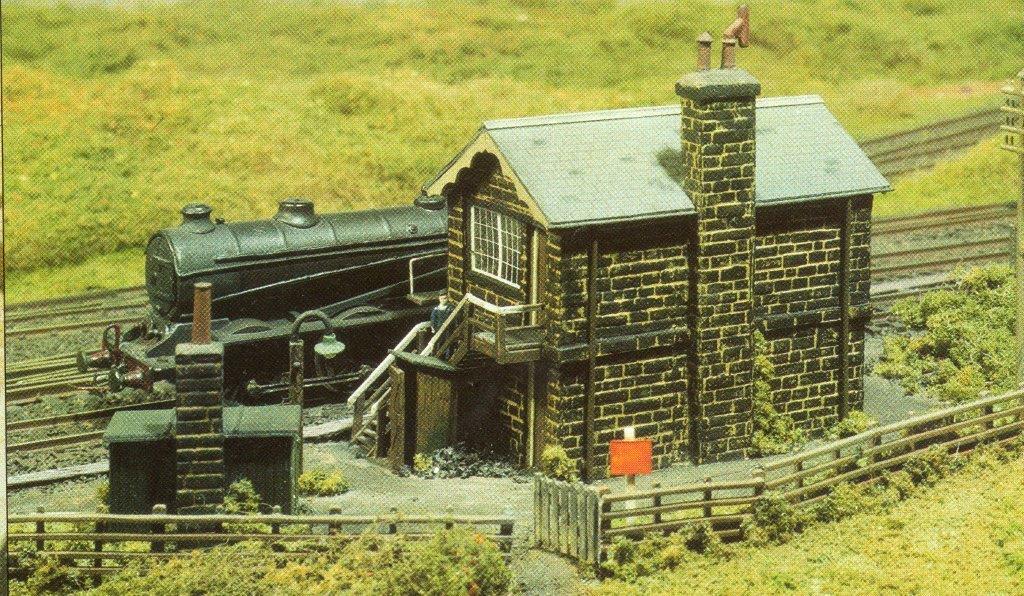GUISBOROUGH in N scale.
Ian Payne.
Prototype.
Guisborough (or Gisborough in mediaeval times) is the former capital town of Cleveland and these days a busy and interesting market town full of character. The town is dominated by the priory which looks down from its high vantage point. One part of the town which is visible from the priory is the Health Centre and one of the town car parks, both being fairly recent developments. The site they occupy was formerly the railway station and goods yard.

The railway to Guisborough was built by the Middlesbrough & Guisborough Railway Company and opened to passengers in 1854. The main reason for the railway though was the large deposits of ironstone in the area. This traffic was so intense that the Cleveland Railway also built a line in the area which crossed over the M&GR line approximately three quarters of a mile from the station. When looking at a map of the railways in this area it is surprising just how many short branches to mines there were. The output of the ironstone mines peaked in 1874 with more than 4,000,000 tons leaving the area via the railway.
The Stockton & Darlington Railway leased the M&GR from the start. It became part of the North Eastern Railway in 1863. The Cleveland Railway also became part of the NER in 1865. This meant that the two routes from Middlesbrough to Guisborough were owned by the same company -inevitably this situation was not to continue. A connection was made between the M&GR and the CR at Hufton Junction where they crossed in 1861, which allowed the CR to be abandoned between the two towns. Guisborough was now at the end of a spur from the main line and this made operations difficult. Trains from Middlesbrough called at the station, but then had to reverse back to the junction to resume their journey onwards to Loftus, Saltburn or Whitby. Return trains did the reversal into the station.

Life went on in Guisborough, the North Eastern experimenting with push-pull trains and railcars to ease the operating difficulties, The track layout was rationalised several times. In 1932 the signal box was closed and the double track which fed the station became two independent lines from Hufton Junction (now Guisborough) signal box, one for passenger and the other freight. In the 1950s the bay platform and some of the sidings were lifted. If Guisborough is remembered for anything it must be the speed with which it was closed. The proposal for closure was made on June 14 1963, the line closing to passengers on February 29 1964 and to freight on August 31. The site was cleared in 1967.
Very little remains of the railway in the town today except a small part of the coal cells in the foundry yard, various bits of walls and a footpath. People in the know will also recognise three trees which lined the entrance from Bow Street. The Health Centre entrance is the original station entrance.
The model
Use diluted PVA applied with an eyedropper - No, I don't intent to repeat all that but just to share some of the different methods which were used in the construction of Guisborough.
Why Guisborough? The answer lies in the late Ken Hoole's book 'North Eastern Branch Line Termini. At the time I was a dedicated GWR in the 1930s' modeller in 4mm scale. This came from having spent many years on 305mm to the foot railway activities at Didcot with the Great Western Society followed by many years working on steam specials across the country. I also had experiences with Lone Star Treble 0 in the 1960s, which was enough to put anybody off the smaller scales! Change was in the air though and I became a convert to N gauge because of the possibilities of "the railway in the countryside" rather than just the railway being portrayed. The 00 models and layouts were sold and the rest is history as they say!

I found the station building at Guisborough fascinating and just had to construct a model of it. All this coincided with an association with the late Derek Rickers, a fellow member of The Association of Shrewsbury Railway Modellers, who modelled in N gauge. It was a revelation to watch the perfect running and overall effect of today's proprietary N gauge stock. I was hooked.
Several visits were made to the town, its library, and the county library at Middlesbrough to amass as much information as I could. These visits were helped by various unknown individuals who, when seeing a stranger taking photographs of a car park, enquired as to why. When informed of the reason for this strange activity, they were most forthcoming with suggestions as to who to contact who might know more information.
The museum in Guisborough has in it a small scale model, possibly 1:500, which was constructed when there was a feature on the railway some years ago. This revealed some of the details that I was having trouble checking. Contact was made with its constructor, Andrew Pearson, who is also a local and who provided lots more details. The area taken up by Guisborough's station was quite extensive. This has required some use of modellers licence in the goods yard and the station area. The whole length has been shortened by approximately 25%.
There are two baseboards, each 4' 6" long by 2' wide constructed in ply in a similar fashion to a hardboard door. Each board consists of two layers of 10mm ply separated by a honeycomb of 10mm and 4mm spacers approximately 4" deep. The top surface was then cut away except for the part below the tracks and station then the bottom layer has the centre cut away to allow access for wiring, point motors and all the sundry bits which lurk below our layouts. The tops of the spacers are then cut to the contours of the scenery. Backscene boards are then attached to the rear of the scenic section and ends. The completed boards are bolted together with bolts and supported on simple trestles with height adjusting screws attached.
The scenic section is 18" wide and divided by the backscene from the fiddle yards which occupy the space behind. All controls and electrics are housed in the honeycomb below the fiddle yards. The layout has end plates which secure the two sections face to face for travelling. The complete layout, two sundry boxes, operators and tea mugs all fit into an average hatchback car,
The track plan dates back to the early 1930s and is used as a conventional station in the fact that the trains arrive then the loco runs round to continue its journey. These departures from the prototype are to allow for more interesting operation as the layout was built purely for showing at exhibitions. This allows for at least one train to be moving at any time on the front of the layout, as one of my pet hates is to pay for entry to an exhibition only to be confronted by layouts which only rarely see moving trains. Anybody who has watched Guisborough at an exhibition may come away with the impression that with the number of movements in the station the whole of Yorkshire is being evacuated, but I believe there should be lots of trains when there are paying members of the public watching.
Track and scenics
Trackwork is Peco code 55 with a hand-built single slip in front of the signal box. A lot of care and time was spent laying the track, testing and checking for perfect running before the PVA was let loose. Why do people use an eye dropper? Try a washing up liquid bottle, its much quicker!!
Points are operated by Seep point motors with micro-switches connected for switching power as the Seep built in switches proved to be less than 100% reliable. There are only two signals in the station area situated at the end of the platform. They were constructed from various oddments of brass tube, sheet and wire. They are operated from two relays placed below the baseboard, with very fine phosphor bronze wires running inside the main post to the arms.
Control is from either of two positions by handheld Gaugemaster or ECM feedback controllers which plug into DIN sockets on the rear of the layout. Most of you will have read the letters in the model press about possible problems with the use of feedback controllers and N gauge motors. Whilst there has obviously been a problem with this combination, I must say that I have always used feedback controllers and have yet to experience any trouble. Perhaps the problem arises with use on continuous layouts. Great care was taken with working out the track feed locations so as to allow maximum flexibility for operations within the station. All solder connections to the track are made on the operating side of the rail to ensure that no unsightly blobs of solder show to the viewing public.

The station provides a perfect setting for a model being backed by a street of houses and shops with a large foundry, finishing at the country end in an overbridge. The backscene was painted by my wife Tricia and has received much praise. Not bad for her first try at this type of work and I can guarantee it won't be her last.
The basic land shape was created with polystyrene which was then sanded smooth. I have found that a coat of plaster is not required which in turn helps to keep the weight down and allows a degree of flexibility which is a bonus on a transportable layout. Everything was then coated in a mucky neutral emulsion paint and sealed with Unibond. Grass is represented by carpet felt which seems not to be used much in this scale. It is dyed with Dylon or similar fabric dyes in various shades of green, stuck down and plucked off until I was happy with the overall impression. I then used a beard trimmer to shorten it even further, so now you know when you see the layout at an exhibition that I am the one with the beard! When I was happy with the overall length, a small amount of commercial ground cover from Greenscene & Woodland Scenics was sieved on top of a good coating of cheap hair lacquer. When the correct appearance of the countryside was gained, another overall spray with hair lacquer finished the job. Bushes and trees are made from coarser grades of foam again attached with lacquer to foliage fibre, steel wool or twisted wire. Some of the trees have been made for me by my good friend George Nutter.
The buildings are constructed from Slater's Plastikard. I generate most of my pleasure from the construction of the buildings, so they get more than their fair share of time devoted to them and their details. In fact, whilst exhibiting at St Albans in January we were intrigued to see a man on his knees studying the station building. When we asked what he was looking for he mentioned the building identification plates which were attached by the Stockton and Darlington Railway for maintenance records. Said gentleman left happy and laughing when I pointed them out to him!
The method I use to construct buildings is to form a box from 2mm clear polystyrene sheet which can be bought from DIY stores for about £6 for a 6' x 2' sheet (or cheaper if you find a damaged sheet), but be careful to ensure it is polystyrene and not acrylic as Mekpak or similar solvents do not bond well to acrylic. The clear box is then covered by embossed Plastikard with the windows cut out. It is then just a question of adding more and more details to your taste. With this method the buildings remain square and straight for longer than unsupported Plastikard with Plastikard windows would do. The finished item might end up with eight or ten layers to give the depth and detail required, but I have not had any problems with warping to date.
Rolling stock
The prototype was serviced from Middlesbrough loco shed with various ex-LNER types supplemented with BR standards. The model has LNER A5s, J39s and J27s together with BR Standard Class 4 tanks and Moguls. Diesels are represented by Brush Type 2s and Sulzer Type 2s. These are supplemented with LMS 8Fs, 'Crabs', Moguls and 4Fs which are on loan to Middlesbrough to cover a temporary loco shortage in the area! Various DMUs are used which may also have been seen in the area. Coaching stock consists of BR Mk.l corridor and non-corridor stock with further items of kit-built LNER Gresley and Thompson stock. The freight side is very varied from many different sources.
I am often asked at exhibitions how do I get the locomotives to run so slow and reliably. This is due to taking lots of care with cleaning of track and wheels prior to shows. Most locos have extra pickups via tender, bogie and pony wheels. The bogie and pony pick-ups are quite simple to add. I use two main methods. The easier method is to have each axle pick-up on one wheel only. This is achieved by drilling a 1 mm hole parallel with the axle between the axle and wheel centre. Into this hole is pushed a short length of 1 mm brass rod which destroys the insulation between the two. File this wire flush on the outside face and touch in with paint. Next remove the opposite wheel and thread on a short length of brass tube slightly larger than the axle diameter. It is important that this tube is free running on the axle. Solder a length of very flexible multi-strand wire to the brass tube then attach to a convenient pick-up point, re-assemble the bogie/pony, check for free running and that is all that is required. To achieve pick-up on both wheels, the axle will require to be split and rejoined with plastic tube or similar then the above work carried out on each side. Another modification made to some bogies/ponies is to spring them to hold them to the track to assist with current pick-up and also stop them derailing over pointwork. This is achieved with the use of 2mm scale handrail knobs and wire. Two knobs are mounted underneath the loco on the centre line of the chassis and one on the bogie/pony. A length of handrail wire is then threaded through the three knobs and a touch of superglue or solder is placed on one of the loco mounted knobs. Bend the wire to achieve slight downward pressure and there you have it - a bogie/pony that is sprung both vertically and laterally. I have found that this modification cures even the worst derailing locos and the modification only takes about an hour.
As might be seen from the photographs, my pet hate is the ever clean railway scene sometimes portrayed. All rolling stock, buildings, scenery, in fact anything that stood still, has been weathered or shows signs of decay. The layout portrays the final years of the station and most rolling stock when little attention, if any, was paid to cleaning or repairs. Weathering has been achieved with a mix of most of the already published methods. I use the weathering powders quite a lot, but find the colour range somewhat restricted. Whilst browsing in a local art shop I came across a range of colouring pencils called Conti Pastels. These, when rubbed on a file, give a pigment very similar in nature to commercial powders, but with infinite colour availability and cheap into the bargain.
In conclusion I would like to thank everybody who has helped with the research, construction and exhibiting of Guisborough. There have been many times when I have been stuck for information or inspiration and a helpful comment has made all the difference.